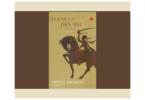Mughal Emperors and their conquest of India has held great fascination for readers for a long time. Most of popular literature surrounding the Mughals , however, been very male-centric. Ruchir Gupta’s “Mistress of the Throne” is a welcome change. It is a part-fiction, part-real story of Jahanara, the oldest daughter of Mumtaz Mahal and Shah Jahan and the only daughter to become Empress of India and wield the muhr uzak, the royal seal.
Upon the death of Mumtaz Mahal, Shah Jahan declares 17 year old Jahanara, his oldest daughter and elder sister of Aurangzeb, the First Lady of the Empire, bypassing his other wives. At a young age Jahanara is faced with the daunting task of bringing her father out of his mourning (by encouraging him to build the Taj Mahal), overcoming her own desires for a family, reconciling to the fact that Mughal Princesses were banned from marriage and advising on affairs of the state during a time of high political unrest. The story traces Jahanara’s evolution from an outspoken and upright princess to a world-wise Queen who will go to any extent to keep her kingdom safe. This includes trying to avert the bloodshed that would be caused if her brothers fought each other for the throne, just as her father and his brothers had done a generation earlier.
The book offers an interesting picture of the women in the Mughal courts, the intrigues, the jealousies and even the love and affection between mothers and sisters. It brings into limelight little known characters such as other wives of Shah Jahan – Princess Kandahari, Taj Bibi, and sons – Prince Murad and Prince Shuja, and takes us through the childhood years of Aurangzeb, Dara Shikoh, Jahanara, Raushanara, Shuja and Murad. This helps the reader understand why each of them developed the personalities they did . It also adds some interesting fictional characters like the love interest of Jahanara – Gabriel and the zenana entertainer Henna Begum.
Written from the perspective of Jahanara, the book provides an insider’s insight into the plight of women during the Mughal rule. The contrast between the Shah Jahan, a patron of art and architecture who believes in religious tolerance to expand his kingdom’s wealth, and the orthodox Aurangzeb, who views art, architecture and religious tolerance as a violation of the teachings of Koran is stark. While Shah Jahan readily appoints his daughter as the Empress, Aurangzeb believes in keeping his sisters, wife and daughters strictly veiled, and confined to the palace walls.
“Mistress of the Throne” is an interesting book for anyone who enjoys history based fiction. The narrative is well developed and there are no loose ends, which leaves one with a sense of satisfaction at the end of the book. The cover could have been better since the image used has nothing Mughal-ish about it. But beyond that it is a great book and worth the time spent.
Be a good Samaritan: If you liked this review, please share it with others. If you did not, share it with us in the comments below
We regularly publish original book reviews which you can be read here. Contact us if you are an author/publisher and want us to review your work.
Our affiliates:
If you would like to purchase ‘Mistress of the Throne’ by Ruchir Gupta, you can do so from our affiliates at
Flipkart: Mistress of the Throne: The Mughal Intrigues
Amazon (Paperback): Mistress of the Throne: The Mughal Intrigues
Amazon (Kindle Ed.): Mistress of the Throne (The Mughal intrigues)
Tell-A-Tale gets a small share of the purchases you make from the affiliate link, helping us bring you the stories you love to read.





